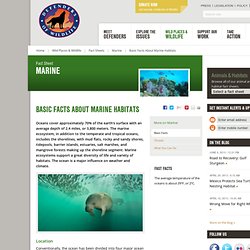

Science for Kids: Marine or Ocean Biome. There are two major aquatic or water biomes, the marine biome and the freshwater biome.

The marine biome is primarily made up of the saltwater oceans. It is the largest biome on planet Earth and covers around 70% of the Earth's surface. Go here to learn more about the world's different oceans. Types of Marine Biomes Although the marine biome is primarily made up of the oceans, it can be divided up into three types: Oceans - These are the five major oceans that cover the world including the Atlantic, Pacific, Indian, Arctic, and Southern Oceans.
The ocean can be divided up into three layers or zones. Sunlit or euphotic zone - This is the top layer of the ocean and it gets the most sunlight. The marine biome has the most biodiversity of all the biomes. Here are just a few of the animals that you will find in the marine biome: Little Known Facts About The Ocean. Orcas (formerly known as killer whales), Orcinus orca, are actually dolphins.

They are the largest of the dolphin family (Family Delphinidae with about 32 species, including the dolphins, pygmy killer whales, Feresa attenuata, and false killer whales, Pseudorca crassiddens). Next to humans, orca are the most widely distributed mammal. Orca inhabit all oceans of the world but are most numerous in the Arctic, the Antarctic and areas in nutrient-rich cold water upwellings. They have been sighted along the shores of Washington, Oregon, California, Baja California, and along the eastern coast of the United States.
More... Great white sharks, Carcharodon carcharias, aka white sharks, white pointers, blue pointers, man-eaters, manila sharks, have, according to E.O. Great white sharks are the largest known predatory fishes in the sea. Green sea turtles, Chelonia mydas, are Chelonians - which means they have four legs and tough shells made of two parts which join at the sides. In the U.S. Top 10 Facts About Salt Water Ecosystem. Fun Ocean Facts for Kids - Interesting Facts about the Pacific, Atlantic & Indian Oceans. Basic Facts About Marines. Oceans cover approximately 70% of the earth’s surface with an average depth of 2.4 miles, or 3,800 meters.

The marine ecosystem, in addition to the temperate and tropical oceans, includes the shorelines, with mud flats, rocky and sandy shores, tidepools, barrier islands, estuaries, salt marshes, and mangrove forests making up the shoreline segment. Marine ecosystems support a great diversity of life and variety of habitats. The ocean is a major influence on weather and climate. Location Conventionally, the ocean has been divided into four major ocean basins: Atlantic, Pacific, Indian and Arctic oceans. Plants Marine habitats are the home to seaweeds, or marine algae (brown, green, red), sea grasses, which are the only marine flowering plants, and mangroves, located on muddy tropical shores.
Animals Climate.